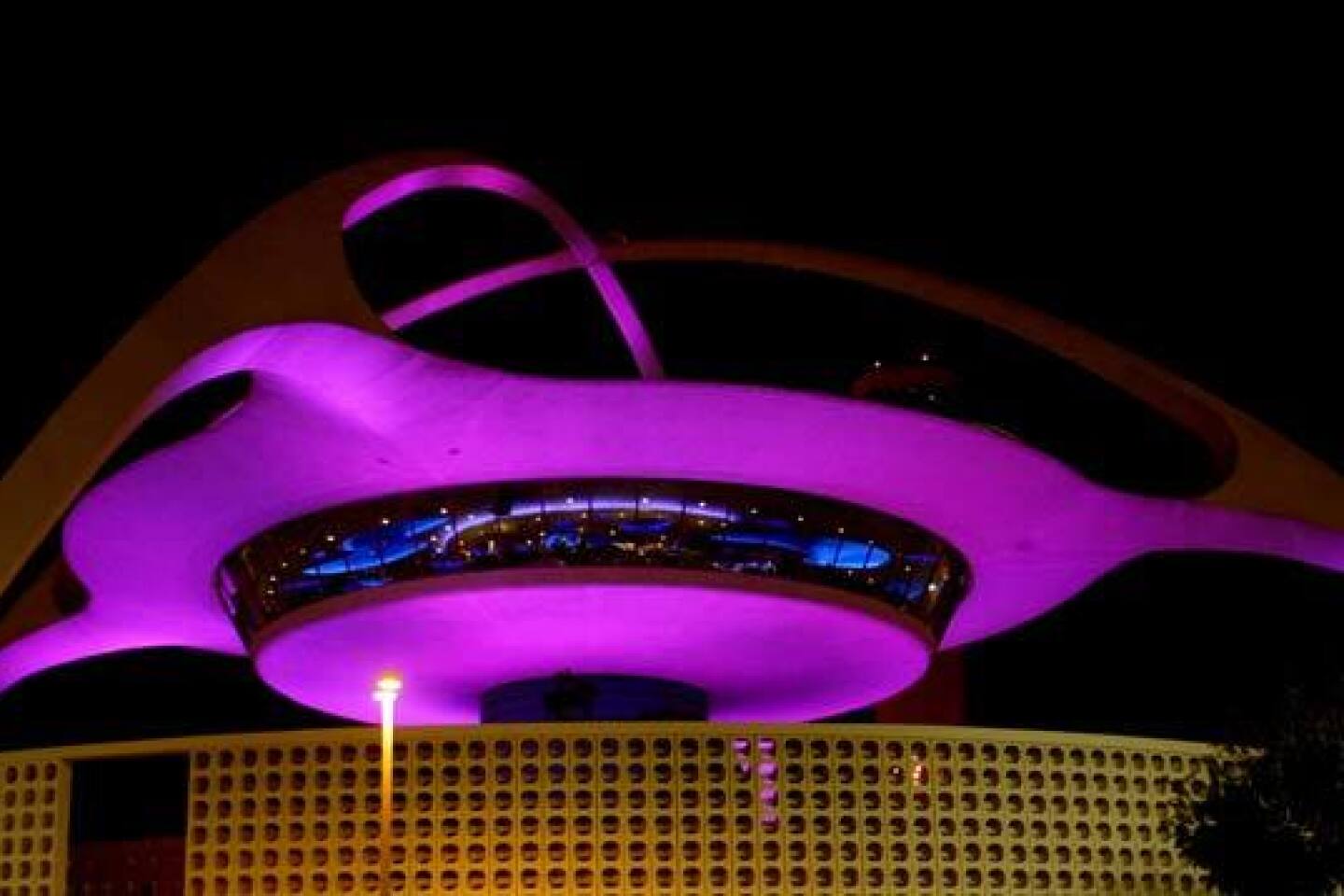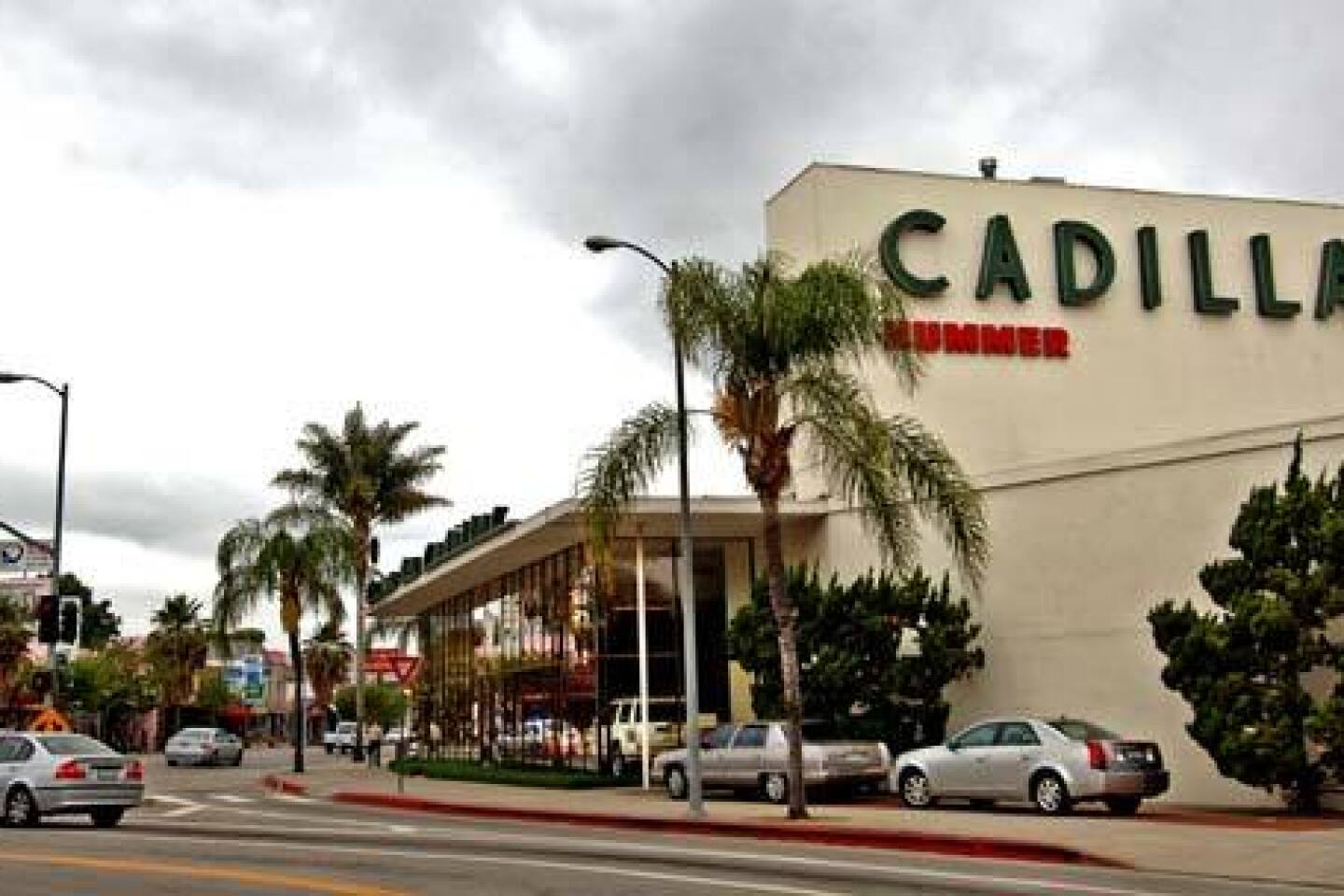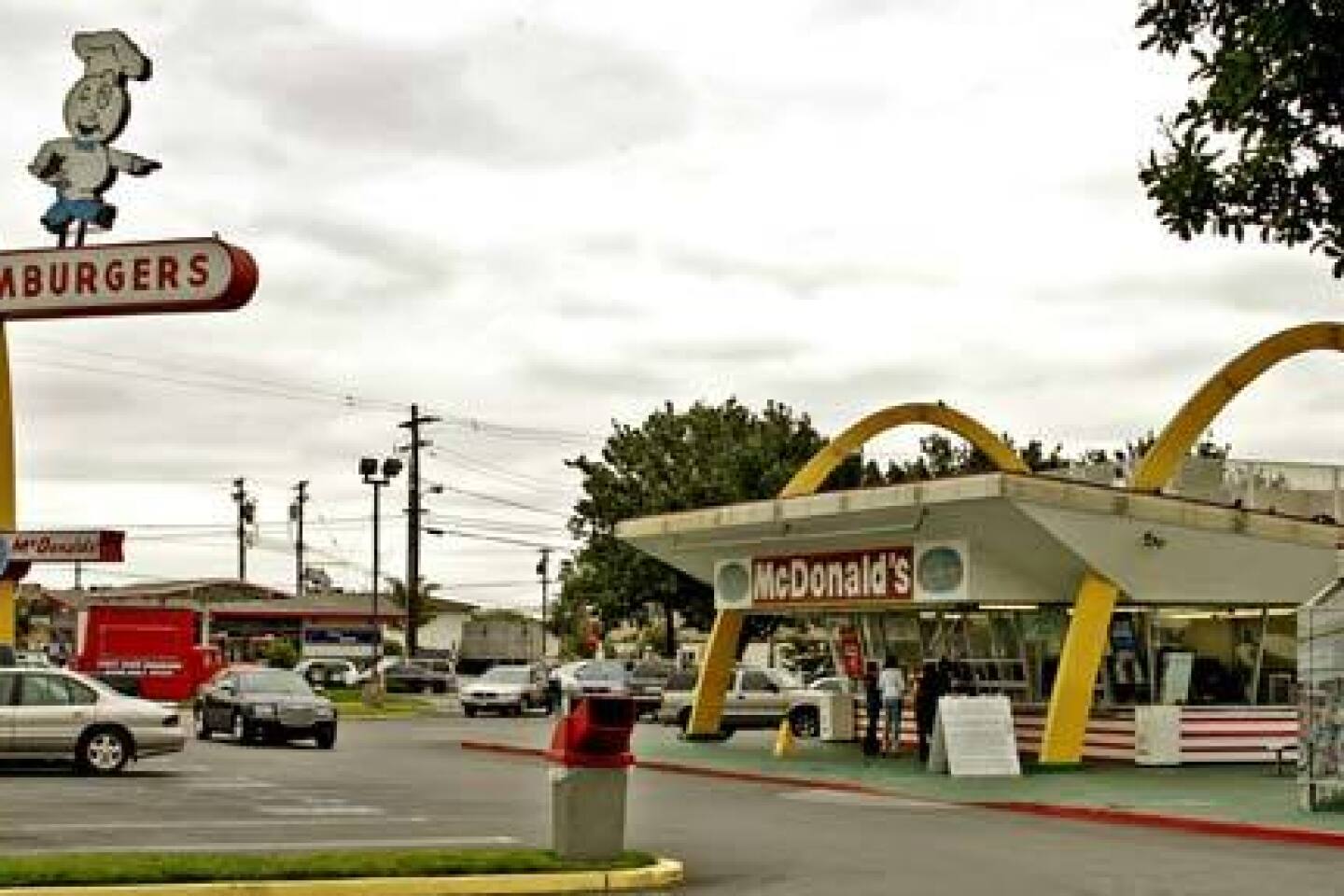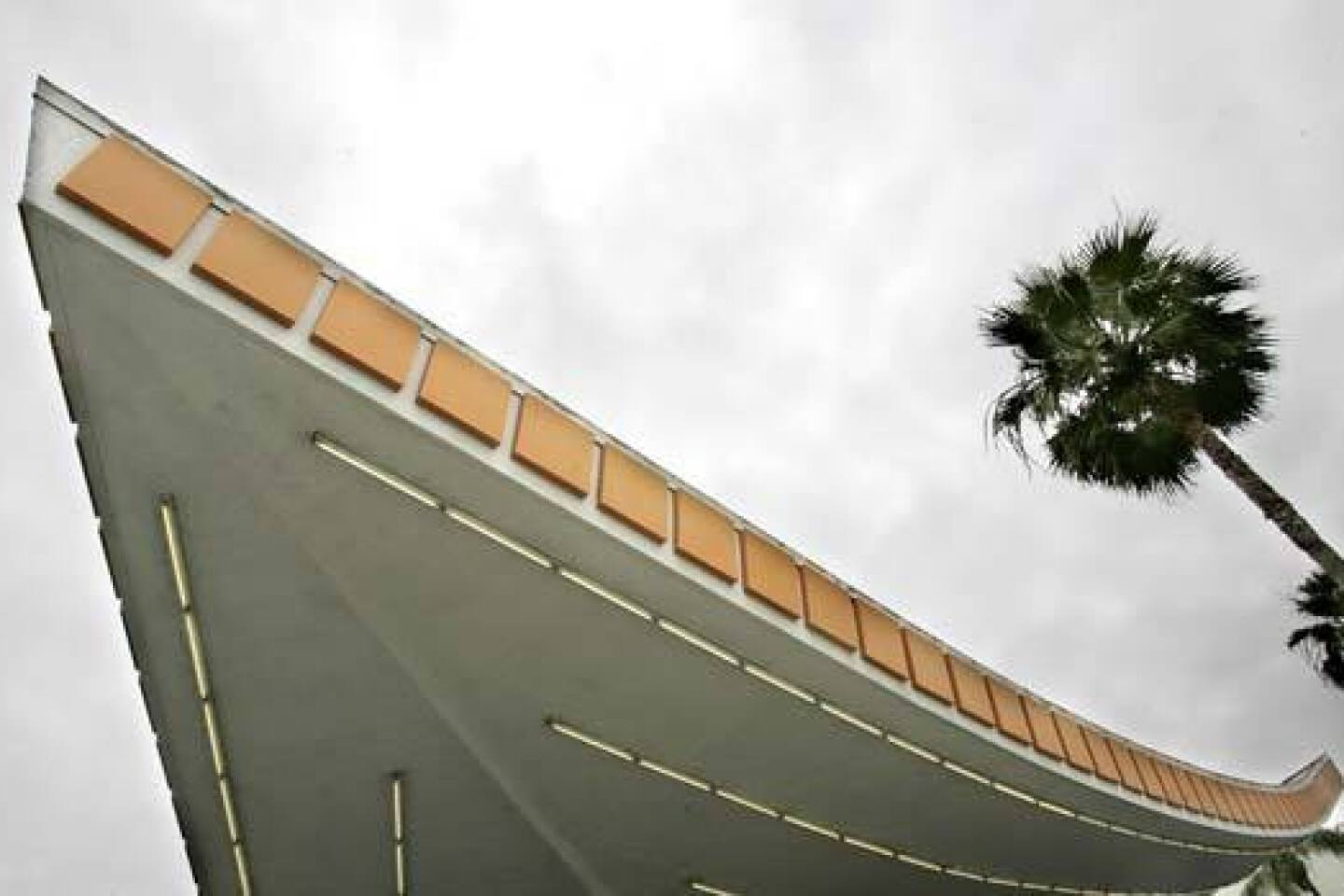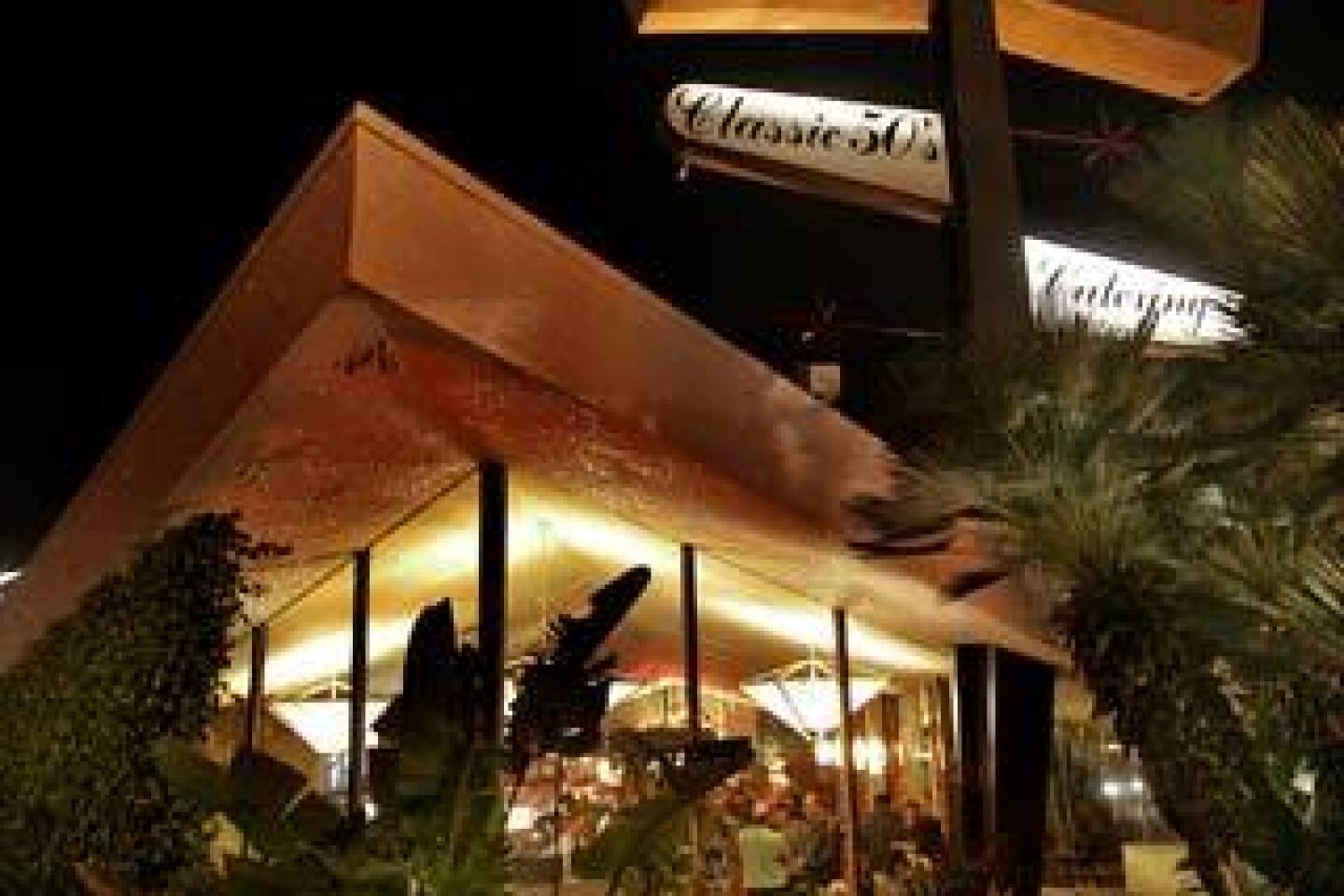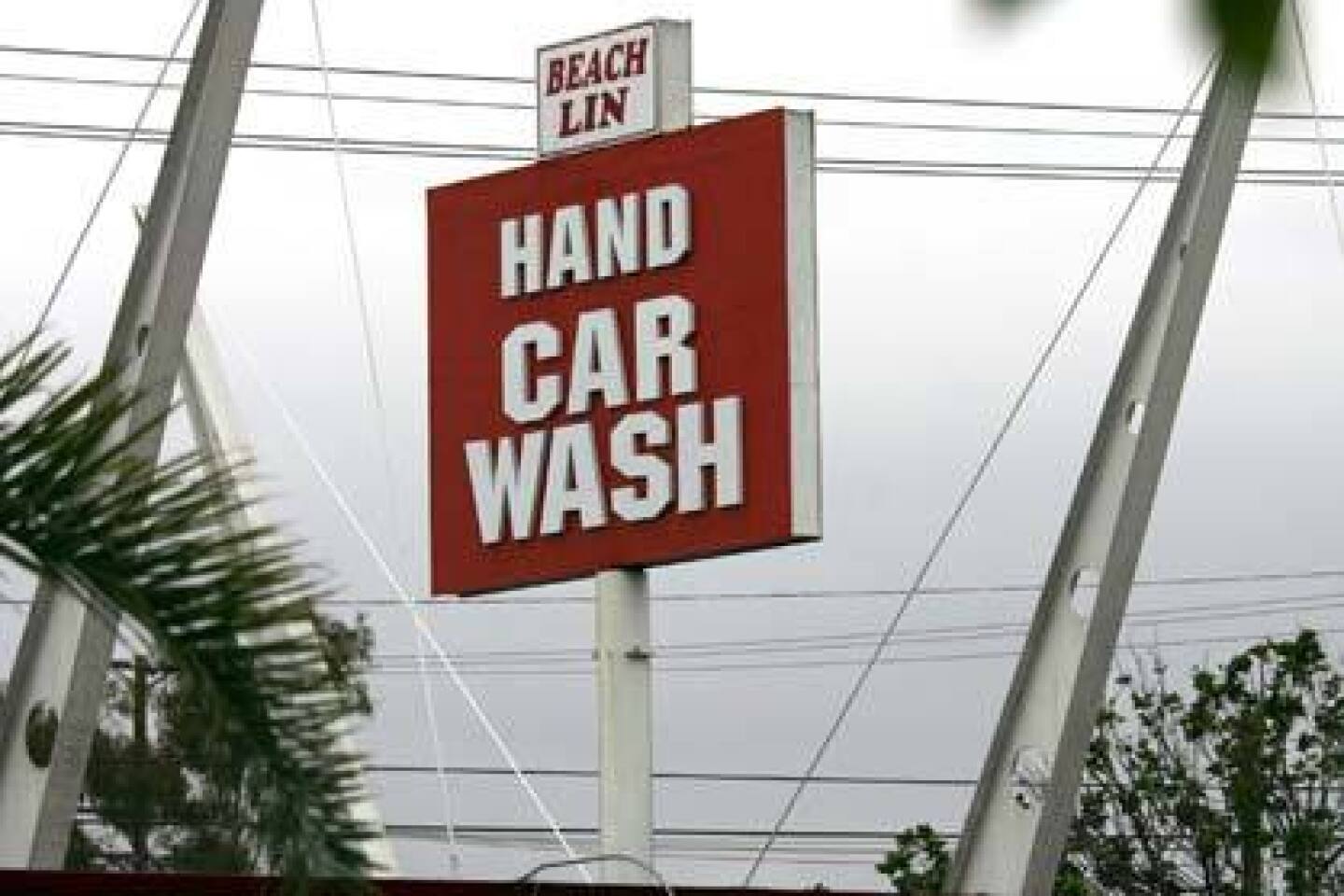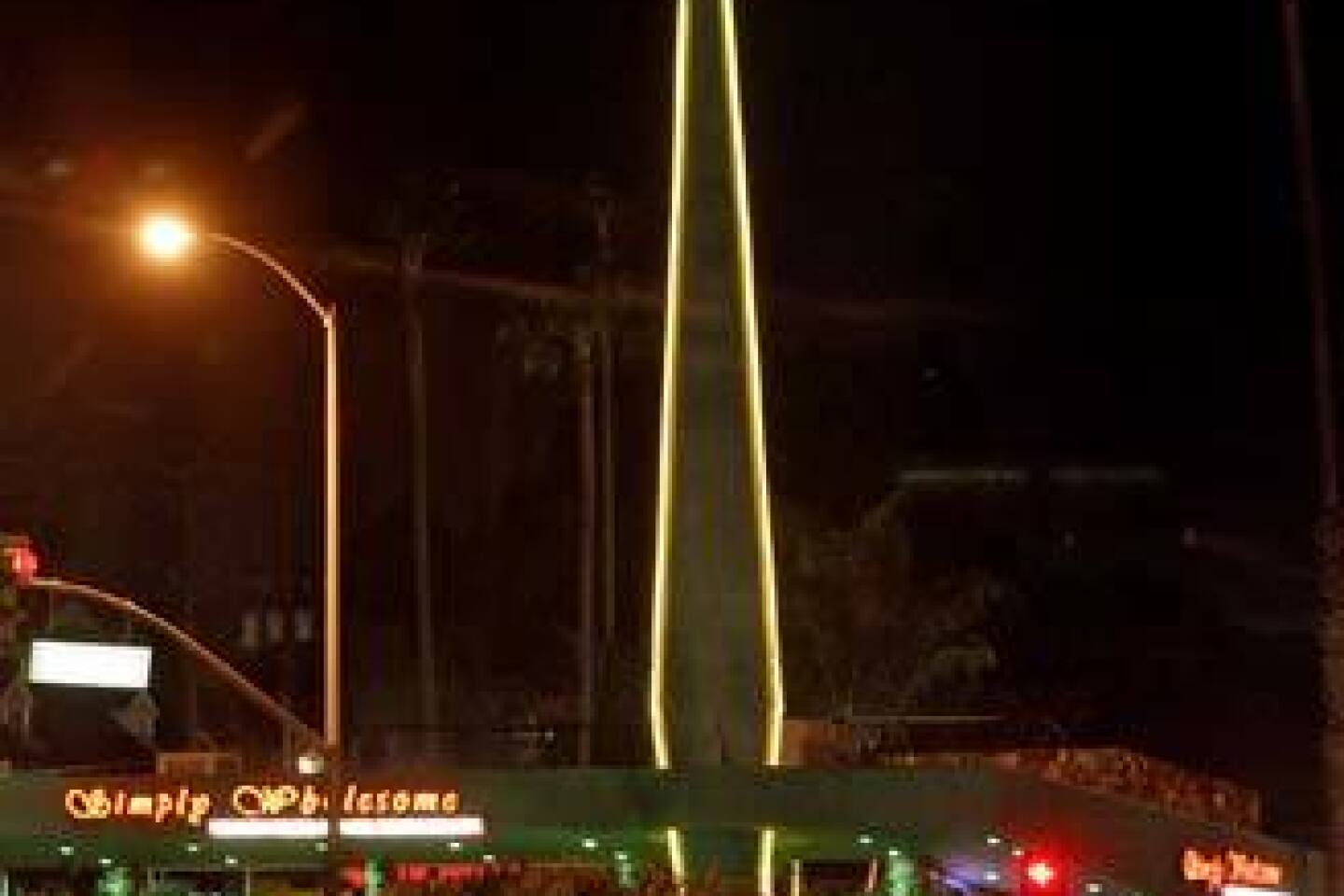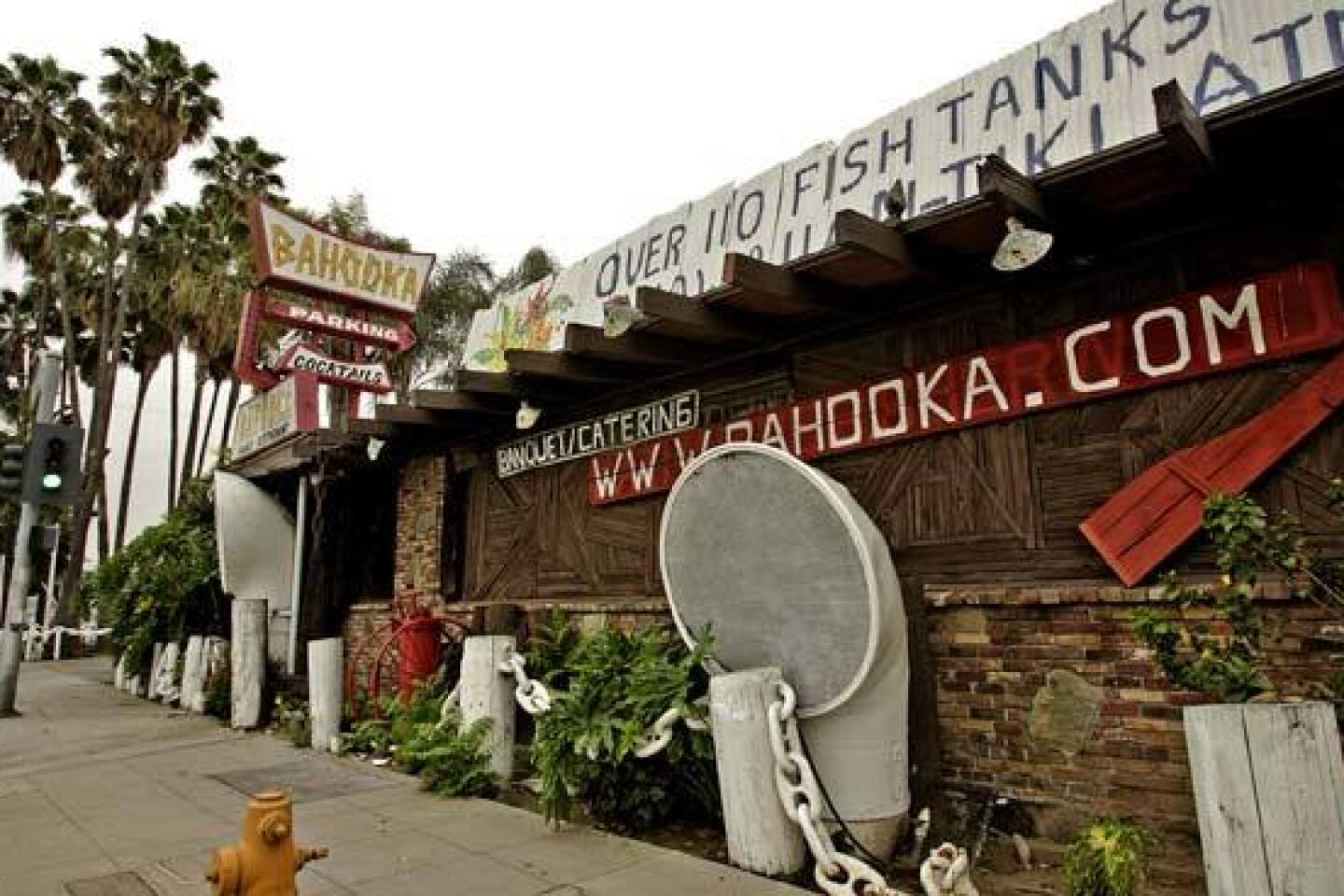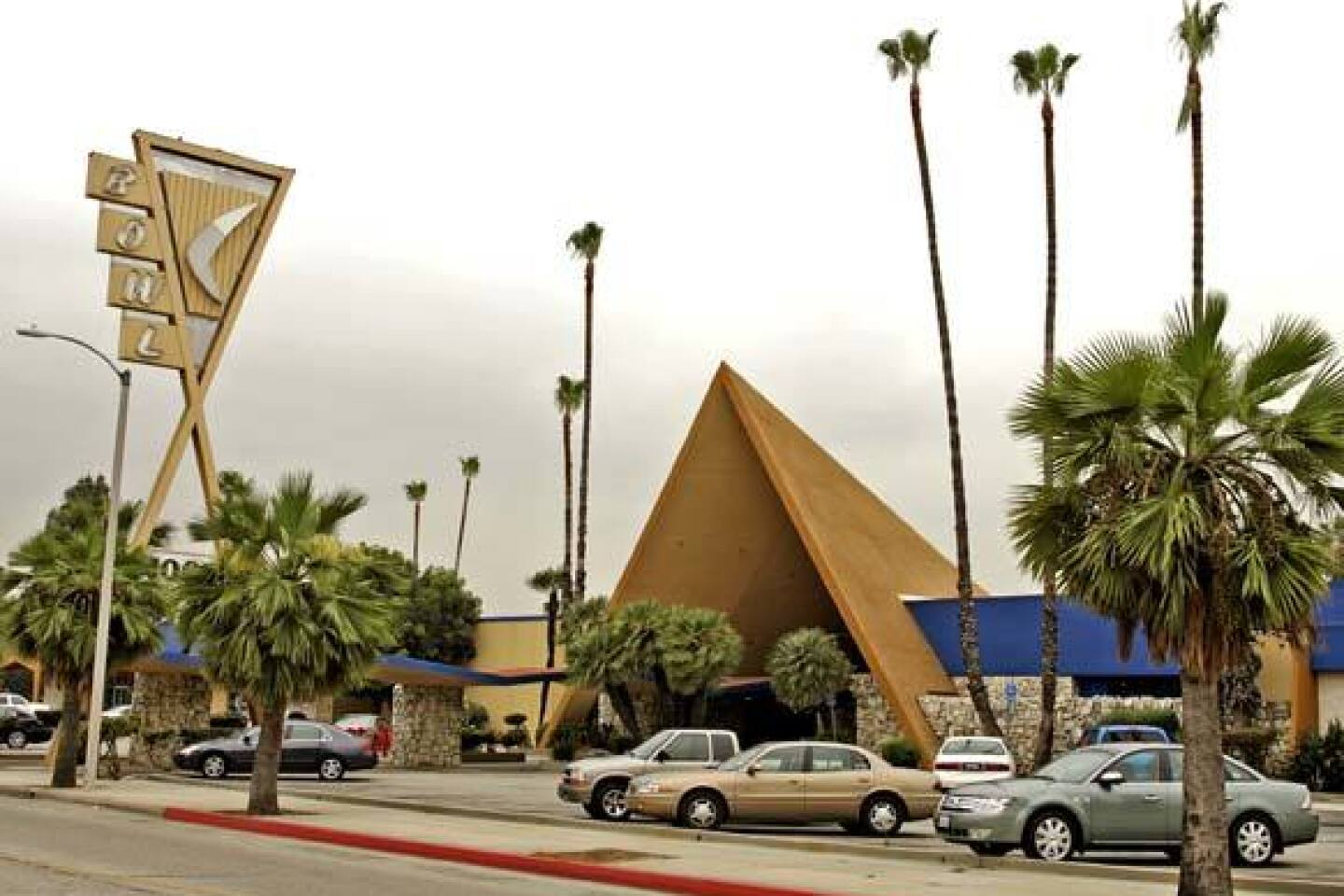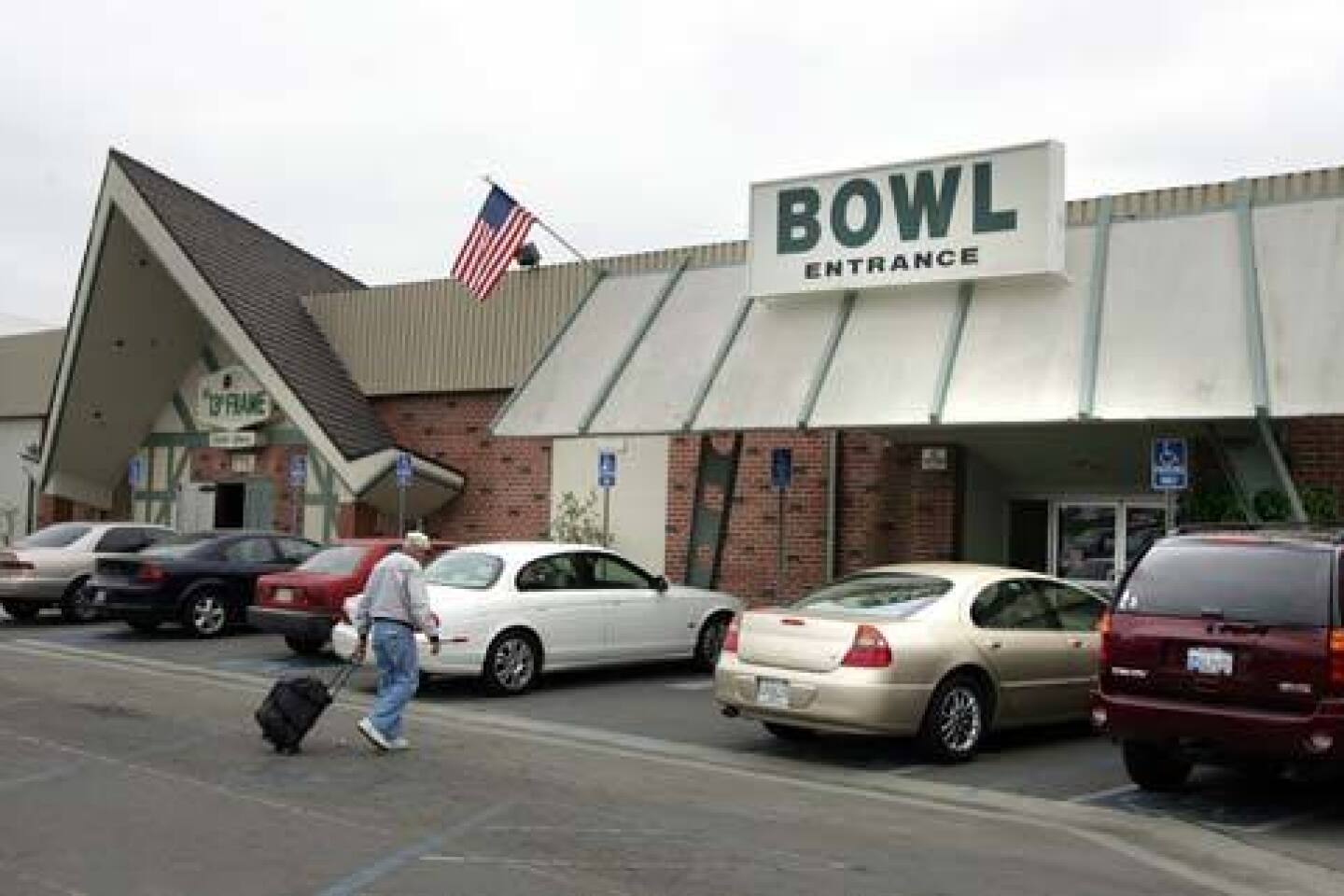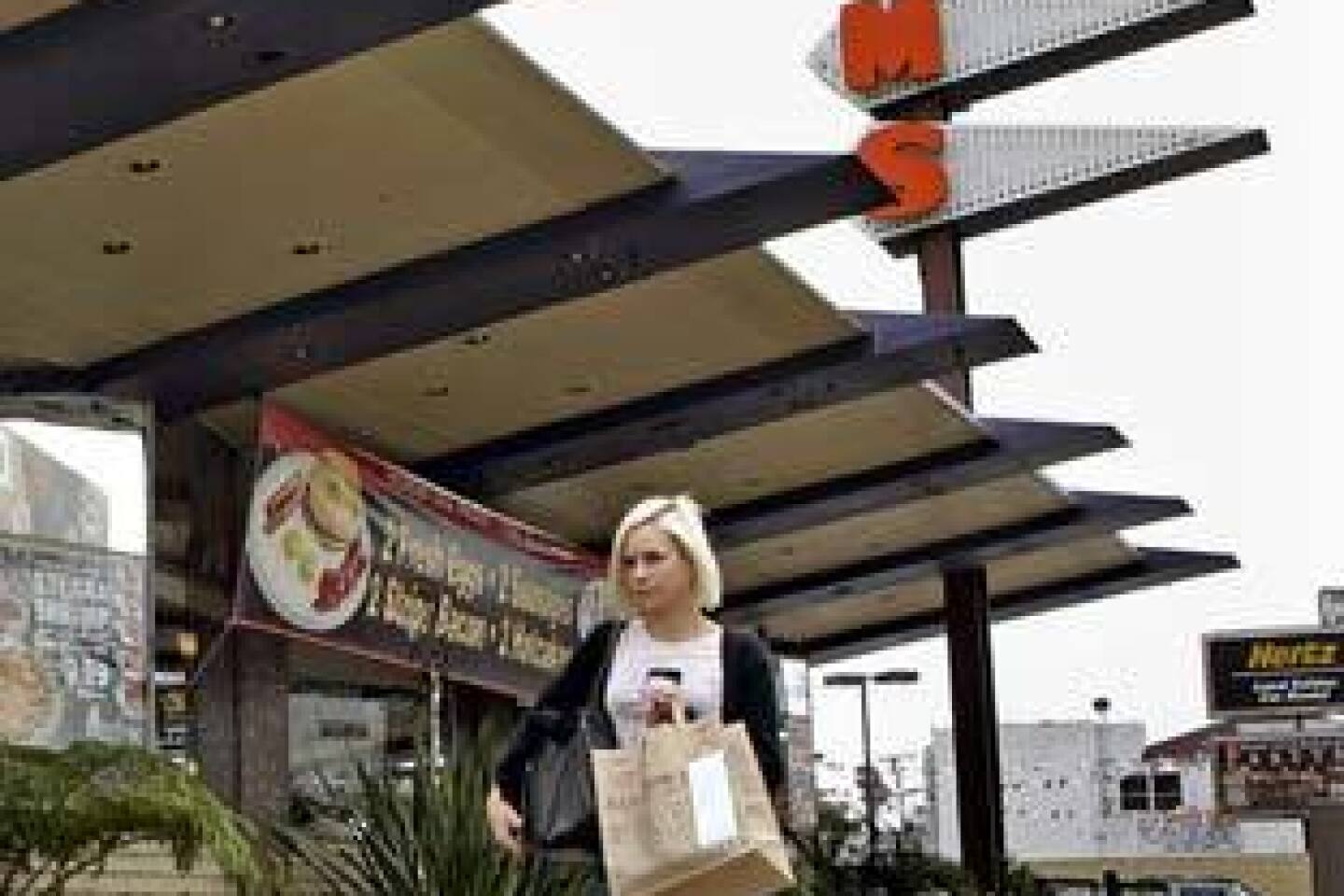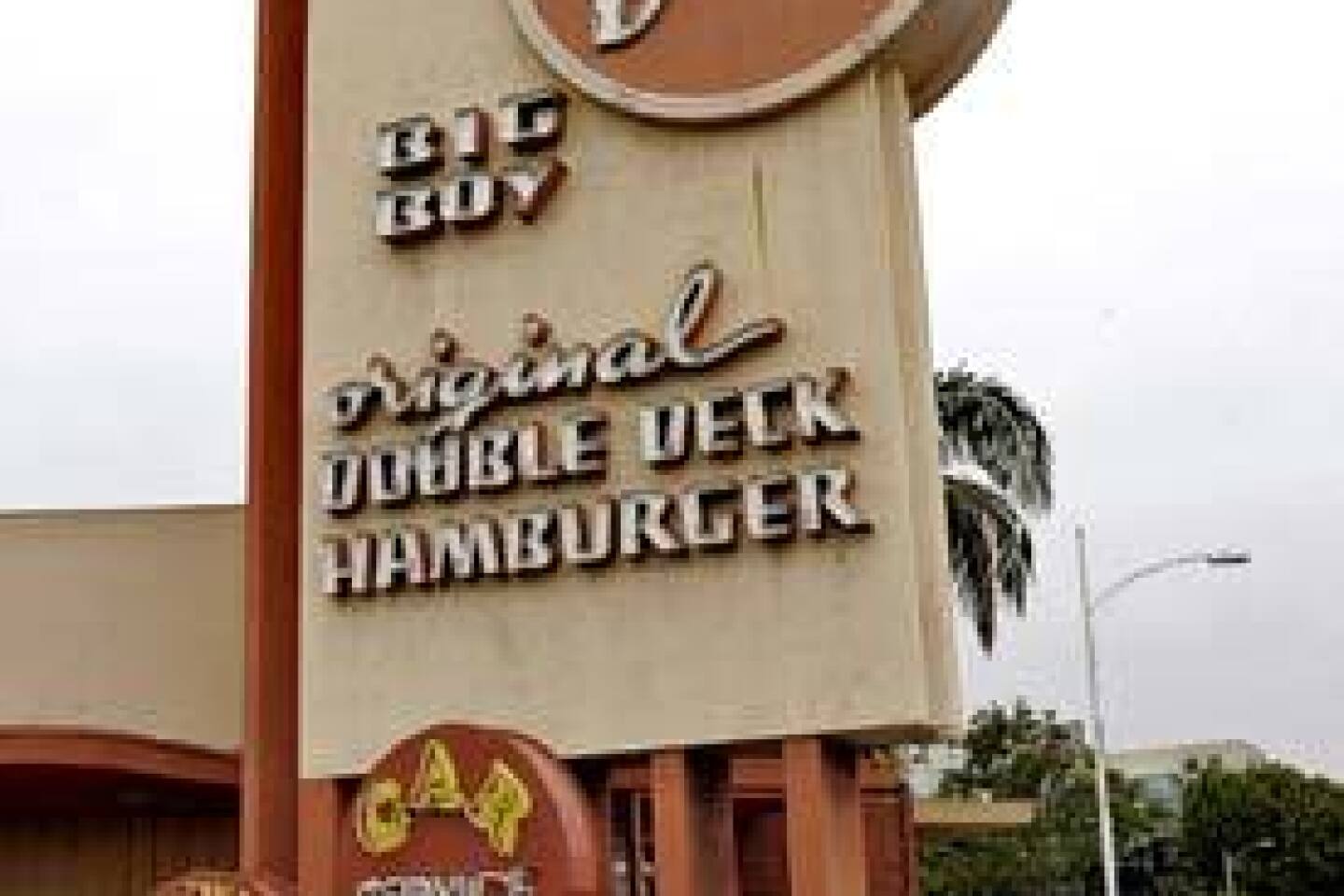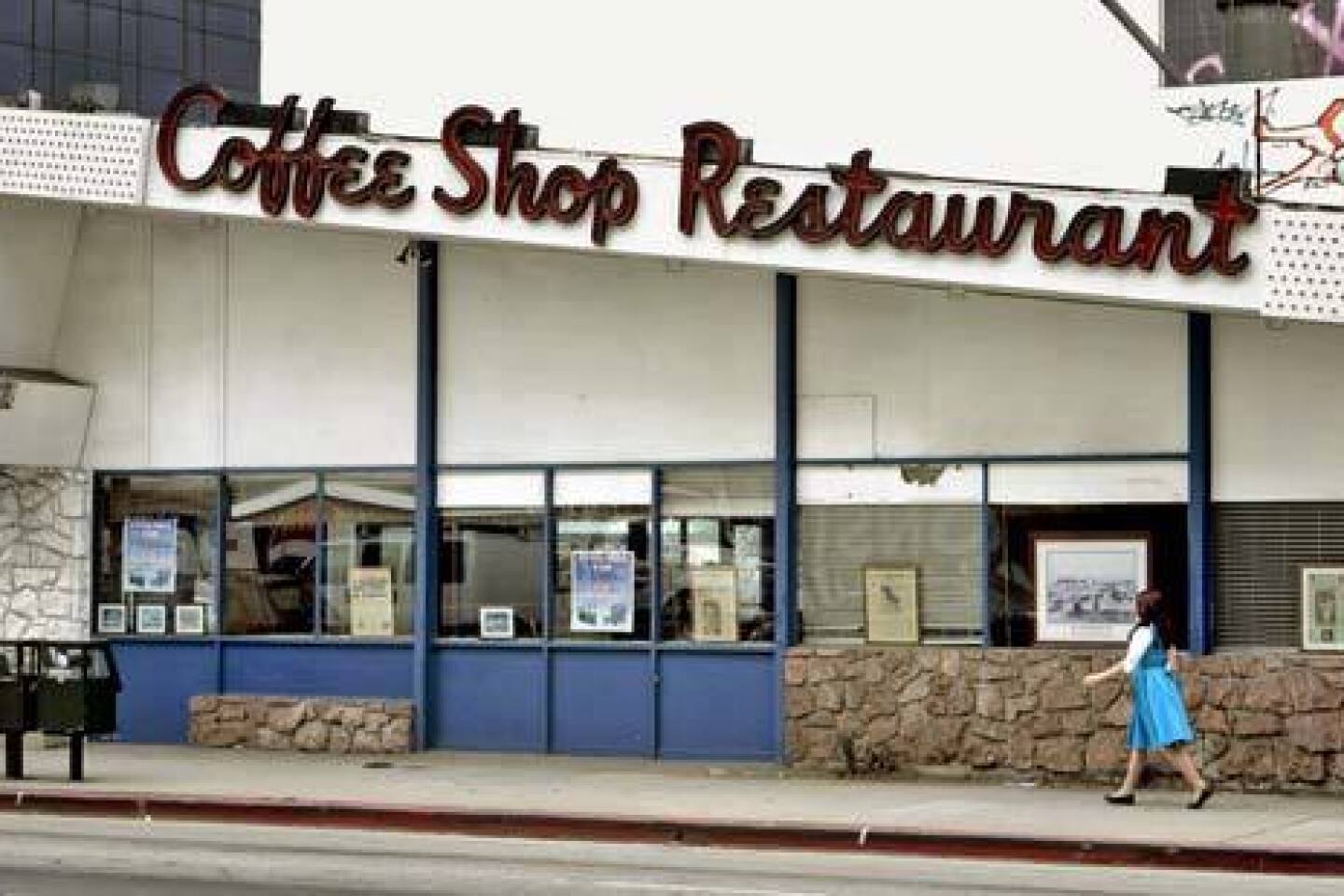Go on a SoCal hunt for Googie architecture
- Share via
It was the 1950s. America was a superpower, and the Los Angeles area was the center of it. The space race was on. A car culture was emerging. So were millions of postwar babies. Businesses needed ways to get families out of their automobiles and into coffee shops, bowling alleys, gas stations and motels. They needed bright signs and designs showing that the future was now. They needed color and new ideas.
They needed Googie.
This whimsical, Space Age look grew out of the Midcentury Modern style -- think LAX’s flying-saucer-like Theme Building -- and became synonymous with Southern California’s fun-loving lifestyle.
Even the story of how Googie got its name is fanciful. Yale professor Douglas Haskell spotted the Googie coffee shop, the eponymous building that once sat at Crescent Heights and Sunset boulevards. He declared the style “Googie” in a 1952 House and Home magazine article.
“Googie is a sub-category of Midcentury Modern that is bolder, more exaggerated in forms,” said Alan Hess, author of “Googie Redux: Ultramodern Roadside Architecture.” Commercial architects such as Wayne McAllister and the team of Louis Armet and Eldon Davis were experimenting with new materials and finding creative ways to lure folks into their buildings, Hess said.
Like most trends, Googie peaked and then began to disappear. Anaheim, once a gold mine of ‘50s architecture, lost most of the Googie motels that bordered Disneyland in the 1990s, architectural historian Daniel Paul said in an interview.
Which is OK with some people.
“People aren’t generally able to appreciate architectural history that happened in their lifetime,” said Chris Jepsen, an Anaheim-based historian who also runs SpaceAgeCity.com, a website covering the Sputnik era. “You tell people that the restaurant they went to as a teenager has history and they look at you like you have three heads.”
But for others, Googie represents an era of hope and optimism. Either way, that carefree attitude now defines Southern California culture. Perhaps, these not-so-ancient relics help remind us of why we’ve come to love it here.
I asked Googie enthusiasts for their favorite examples of the style and compiled this list of what might be considered the best local examples. Keep in mind that they often are located in neighborhoods and suburbs that don’t have the funds or the need to update and modernize every few years, so these won’t necessarily be the ritziest places in town. Still, these are worth making a detour.
So here is the springtime SoCal Googie tour. (Note: More fun if taken in a DeSoto Fireflite.)
BAHOOKA
4501 Rosemead Blvd.
Rosemead
(626) 285-1241
Opened: 1976.
Key characteristics: Polynesian-style design, plant life. Similar styles include the Mission Tiki Drive-In, Montclair; the Tiki Ti bar, Silver Lake; the Tonga Hut, North Hollywood.
Pop culture talking points: Parts of Johnny Depp’s 1998 film “Fear and Loathing in Las Vegas” were filmed here. Rufus, the pacu fish that talks to Depp, lives in the tank next to the hostess stand.
Why it matters: Now that the Beverly Hills Trader Vic’s, the epitome of Polynesian culture reinterpreted on our shores, has been demoted to little more than a poolside lounge at the Beverly Hilton, it’s up to off-the-beaten-path finds to keep the tiki torch glowing.
This Rosemead hide-out pays tribute to the themes and artwork that came back with the soldiers returning from the Pacific theater. Island décor mostly popped up in suburbs, where it was considered new and daring by residents. “Tiki has an escapist and exotic quality,” said Paul. “Since we won the war, we associated it with something positive.”
At Bahooka, crab puffs, beef dips and baked ham are washed down with rum-based Scorpions and Head Shrinkers from 11:30 a.m. to 9 p.m. Mondays through Thursdays, 11:30 a.m. to 10:30 p.m. Fridays, noon to 10:30 p.m. Saturdays and noon to 9 p.m. Sundays.
BEACH-LIN CAR WASH
126 S. Beach Blvd.
Anaheim
(714) 952-3718
Opened: Late 1950s or early ‘60s.
Key characteristics: Free-form design, steel beams and wires.
Other nearby Googie examples: The Anaheim Convention Center, the Linbrook Bowl (although the exterior has been remodeled).
Why it matters: Exposed steel beams interlocked by wire grab drivers’ attention from the road while contributing to a Space Age vibe. “I’ve often told people that I’ve seen these early illustrations of what NASA thought their first buildings on the moon [would look like], and boy, it looks like that car wash,” Jepsen said. Washes are still available 8 a.m. to 6 p.m. Mondays through Saturdays and 8 a.m. to 5 p.m. Sundays.
BOB’S BIG BOY
4211 W. Riverside Drive
Burbank
(818) 843-9334
Opened: 1949.
Pop culture talking points: A Big Boy statue made for a nice escape pod for Dr. Evil in the “Austin Powers” movies.
Key characteristics: Streamline Moderne architecture, large glass windows, plant life.
Noteworthy architect: Wayne McAllister.
Why it matters: The beaming, rotund statue, poised to deliver cheeseburgers and fries, began showing its face at the chain’s first restaurant in Glendale in 1936. This long, orange building is across from the Falcon Theatre. Despite its address, it’s known to most as the Toluca Lake Bob’s, and is the oldest remaining of the chain. The restaurant’s Streamline Moderne design made McAllister’s reputation; he is also credited with creating the circular drive-through restaurant design. Bob’s serves double-decker burgers all day, every day. And for that touch of nostalgia, car-hop service is available from 5 to 10 p.m. Saturdays and Sundays. The Road Kings have a classic car show at the drive-in from 5 to 10 p.m. Fridays.
BRUNSWICK COVINA BOWL
1060 W. San Bernardino Road
Covina
(626) 339-1286
www.bowlbrunswick.com/center_info
Opened: 1955.
Key characteristics: Free-form design, A-frame roof, large palm trees, angled marquee sign.
Noteworthy architect: Pat DeRosa.
Why it matters: DeRosa transformed the no-girls-allowed man caves into “bowling palaces,” said Jepsen of SpaceAgeCity.com. These places brought homemakers in during the day with women’s leagues and childcare service and added clean, well-lighted coffee shops and restaurants for date nights.
Instead of building with prestressed concrete, which was used for major commercial projects but was too expensive for the small business owner, DeRosa made dramatic entryways out of plywood. He was also known for creating themes with his structures, such as the giant pyramid and Egyptian-styled details found at the Covina Bowl. Hit the lanes from 9 a.m. to midnight Mondays through Thursdays, 9 a.m. to 2 a.m. Fridays and Saturdays and 7 a.m. to 2 a.m. Sundays.
CASA DE CADILLAC
14401 Ventura Blvd.
Sherman Oaks
(818) 981-2000
www.casadecadillac.com/index.asp
Opened: 1949.
Key characteristics: Large pane windows, neon roadside signage.
Pop culture talking points: Randall Duell, the architect who designed this building, also designed Magic Mountain in Valencia and the now defunct Lion Country Safari in Irvine.
Architect: Randall Duell.
Why it matters: Car dealerships needed you to pull your old dust wagon off Ventura Boulevard and stop in to look at their shiny cruisers fresh from Detroit. Like the coffee shops, car showrooms were placed on major streets, surrounded by glass, revealing happy customers sitting on new leather seats or being escorted around by friendly, clean-cut salesmen.
At night, neon signs like the one on the front of the Casa de Cadillac building and the always-present showroom lights are enticing. Open 8:30 a.m. to 7 p.m. Mondays through Fridays, 9 a.m. to 5:30 p.m. Saturdays and 11 a.m. to 5 p.m. Sundays.
CBS TELEVISION CITY
7800 Beverly Blvd.
Los Angeles
Opened: 1952.
Key characteristics: Modern entranceway, lightweight-looking materials.
Noteworthy architects: William Pereira and Charles Luckman.
Why it matters: Tired tourists camping out early for tickets to “The Price Is Right” and eager fans hoping to catch a glimpse of the next American Idol before heading to the nearby Grove and Farmers Market might consider CBS’ studio complex, which looks like little more than a giant geometric box, but it has some distinctive Googie traits. Despite its size, the building looks non-gravitational and lightweight. In his book, Hess points out that the “ultramodern entry canopy” has a whimsical flair. To join the curious, check out www.cbs.com/daytime/price/tickets/ for tickets to tapings. Or call (323) 575-2458 from 9 a.m. to 5 p.m. Mondays through Fridays or the 24-hour ticket information line at (323) 575-2449.
CHIPS
11908 Hawthorne Blvd.
Hawthorne
(310) 679-2947
Opened: 1957.
Key characteristics: Concrete walls, glass windows, jutting roof, plant life, steel-beam pylon sign.
Other nearby Googie examples: The Lennox Car Wash; the Brolly Hut, Inglewood.
Noteworthy architect: Harry Harrison.
Why it matters: This neighborhood diner near LAX has changed little since it first opened its doors. “You walk in and it feels like a Googie shop is supposed to feel,” said Jepsen. One wall is made of rock; a gated outdoor patio mixes outside and in. The counter seating, a feature borrowed from submarine design, enhances the space and allows the staff to mop the floors under the customers’ feet.
JACK COLKER UNION 76
427 N. Crescent Drive
Beverly Hills
(310) 273-3891
p66conoco76.conocophillips.com/index.htm
Opened: 1965.
Key characteristics: Space Age-style sloped roof.
Pop culture talking points: The original Union 76 symbol -- a twirling orange ball with a blue “76” painted on it, which used to hang high by the roadside -- was designed to attract drivers’ attention from way down the road.
Noteworthy architect: Gin Wong for Pereira & Associates.
Why it matters: All that cruising meant you’d have to stop for gas. It might as well be a spot that will keep you out of the sun for a bit while the roof’s down. The structure was originally meant to be a part of LAX. The rays of white light that shoot from the sloped triangular roof at night make it look as though it’s ready for takeoff.
LA HABRA 300 BOWL
370 E. Whittier Blvd.
La Habra
(714) 526-2058
Opened: 1960s.
Key characteristics: A-frame roof, pylon beams, neon starburst sign.
Other nearby Googie examples: The La Habra Car Wash, Jack’s Whittier Restaurant.
The glassed-in coffee shop at the corner of the complex -- “a clear knockoff of Denny’s, except better at retaining its character than most of the chain’s locations,” Jepsen said -- makes this a venerable strip of Googie in Orange County. The glowing neon sign flashing a perfect score, an entrance constructed of cutout pylon beams and an adjacent bar with a separate entrance complete the look. The bowling alley is open 9 a.m. to midnight daily; the restaurant’s hours are 7 a.m. to 9 p.m. Mondays through Saturdays and 7 a.m. to 10 p.m. Sundays.
McDONALD’S
10207 Lakewood Blvd.
Downey
(562) 622-9248
Opened: 1953.
Key characteristics: Iconic golden arches.
Pop culture talking points: It wasn’t always Ronald, said Lisa McComb, McDonald’s corporate relations manager. The grinning Speedee the chef -- featured on the sign at this restaurant -- was the hamburger palace’s original spokesman, created by the McDonald brothers in 1948.
Ray Kroc bought them out in 1961 and wanted a new logo. Although a character named Archie and other variations of Speedee have been used, Ronald McDonald showed up in Washington, D.C., in 1963 and is now considered the official spokesman.
Noteworthy architect: Stanley C. Meston.
Why it matters: The oldest remaining McDonald’s was restored in 1996. It now mixes the old -- a walk-up window, towering golden arches and a 60-foot Speedee the chef sign to grab your eye on the thoroughfare and lots of outdoor seating surrounded by a giant parking lot -- with newer additions such as wireless access. Employees in 1950s-style uniforms -- paper hats, button-down short-sleeve dress shirts and black pants -- serve Big Macs, Happy Meals and other classics from 7 a.m. to 9:45 p.m. daily.
NORMS
470 N. La Cienega Blvd.
Los Angeles
(323) 655-0167
Opened: 1957.
Key characteristics: Concrete walls, glass windows, jutting roof, neon marquee.
Pop culture talking points: Why isn’t there an apostrophe in the name? Spokesman Jerry O’Connell speculates that it didn’t fit on the signature orange-and-white sign.
Noteworthy architects: Armet and Davis.
Why it matters: The bright neon sign hangs high -- a trademark of the two architects -- signaling to late-night rabble rousers and early-morning office workers that Norms serves pots of coffee and American comfort food 24/7. Orange-colored structural trusses supported by concrete walls expand the roof, making room for maximum amounts of glass to showcase the crowd. The interior of Norms has been redesigned, but its signage is still instantly recognizable.
PANN’S RESTAURANT & COFFEE SHOP
6710 La Tijera Blvd.
Los Angeles
(310) 670-1441
Opened: 1958.
Key Googie characteristics: Tilted roof and sign, plants and exposed stone walls indoors and out, glass windows wrapping around the restaurant. Pann’s celebrates its 50th anniversary this year. Watch for party information this fall.
Pop culture talking points: The diner has appeared in films such as “Pulp Fiction” “XXX” and “Bewitched.”
Noteworthy architects: Armet and Davis.
Why it matters: Armet and Davis’ firm was one of a handful that became synonymous with Googie architecture, particularly for its work with coffee shops.
Those on the way to and from LAX or just wanting a comforting Sunday brunch can stop off at this (still) family-run diner for chicken and waffles or patty melts and Black Cows from 7 a.m. to 11 p.m. Mondays through Saturdays and until 10 p.m. Sundays.
SIMPLY WHOLESOME (FORMERLY THE WICH STAND)
4508 W. Slauson Ave.
Los Angeles
(323) 294-2144
Opened: 1957.
Key characteristics: Sloped concrete roof, stone walls, indoor-outdoor seating, Space Age-style antenna sign.
Noteworthy architects: Armet and Davis.
Why it matters: It was once an after-school and weekend hangout for suburban teens. Now, the new owners of this Inglewood area landmark have ditched the malts and fries in favor of Caribbean treats and organic and health-conscious items. But some things didn’t change. The owners tried to keep as much of the original design as possible. The stone walls, concrete roof and antenna-like sign are a dramatic example of Googie. Stop in for a veggie burger and fruit smoothie from 8:30 a.m. to 9 p.m. Mondays through Saturdays and 11 a.m. to 8 p.m. Sundays.
FOR THE RECORD:
Googie architecture: A May 18 Travel section article on Googie architecture listed the wrong address, telephone number and hours for the Starbucks at the former site of Ships Culver City. The correct information is 10705 W. Washington Blvd., Culver City, CA 90232; (310) 202-8984. That Starbucks is open 5 a.m. to 11 p.m. Sundays through Thursdays and 4:30 a.m. to 11:30 p.m. Fridays and Saturdays. —
STARBUCKS (FORMERLY SHIPS CULVER CITY)
9718 Washington Blvd.
Culver City
(310) 204-1075
Opened: 1957.
Key characteristics: Glass window panes surrounding the restaurant, concrete siding.
Other nearby Googie examples: Johnnie’s Pastrami, Tito’s Tacos.
Pop culture talking points: The Landmarks Preservation Board in Seattle -- Starbucks’ home base -- declared a Googie-style Denny’s Restaurant a landmark in February.
Noteworthy architect: Martin Stern Jr.
Why it matters: It is fitting that a classic coffee shop and hangout has morphed into . . . a coffee shop and hangout. Ships’ much-loved rocket ship is gone in favor of the new owner’s familiar green lettering, but some of the other details have carried through. “These chain restaurants were all done by established restaurateurs,” Hess said. “They were successful enough to hire decent architects, and they worked closely with them. They knew how high the counter should be. They knew how many tables to have, how many banquettes. And they knew how to make it comfortable enough that they liked being there, but uncomfortable enough so that they wouldn’t sit there forever.” Some things never change. Starbucks is open 5:30 a.m. to 9:30 p.m. Mondays through Thursdays, 5:30 a.m. to 11 p.m. Fridays and Saturdays and 6 a.m. to 9:30 p.m. Sundays.
More to Read
Sign up for The Wild
We’ll help you find the best places to hike, bike and run, as well as the perfect silent spots for meditation and yoga.
You may occasionally receive promotional content from the Los Angeles Times.
